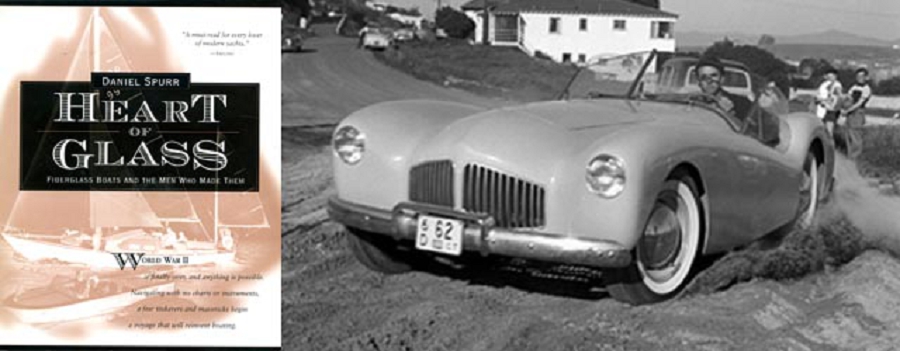
Note:
This is the first in a series of articles on Bill Tritt, his legacy, and his impact on the boating and sports car world. For additional articles in this series on Bill Tritt, click on the link below.
Click Here To Review The Articles Published On Bill Tritt From “Heart of Glass”
———————————
Hi Gang…
It’s with a heavy heart that I share with each of you the news of the passing of Bill Tritt of Glasspar. He was 93 years old when he passed away last week, and lived a long, good, full, productive life . Our condolences go out to his sons, Matt and Greg, his grandchildren which include Inga and others, and his family and friends across the world. Bill will be missed by all of us, and his impact on the world stretched far beyond fiberglass and boats. He was a very special person and I am honored to have called him a good friend too.
I got to know Bill over the past 5 years. Good friend Rick D’Louhy and I even traveled to meet him and his son Greg back in early 2009 one wintery and snowy day. He had retired years earlier to a beautiful log cabin in the woods near Union, West Virginia and when Rick and I arrived, the scene with all the snow looked right out of a post card. Bill surely had an eye for beauty in so many different forms.
Bill and I talked quite a bit from 2006 to 2008 and I have many good memories of our conversations. One in particular always brings a smile to my face. During one talk, we were discussing his memories of how the cars were made and he commented as follows…
“Geoff…I just can’t remember the details. I’m 90 years old now, and my memory is not what it used to be.”
Wanting to make Bill feel better about his memory, I shared with him that I thought his memory was excellent for such a long time ago and he was doing great. His dry sense of humor showed through when he replied:
“Now Geoff…I’m starting to get concerned about your memory…”
Bill was one special guy, and will be missed by everyone in the fiberglass boat and car industry – and well beyond.
(story continued below picture)
Daniel Spurr: Heart of Glass
I think Bill got a kick out of my enthusiasm for learning more about the fiberglass cars he built. More than once he had to remind me that building cars was a very small part of his business. He only built them from mid 1951 thru about 1955 – maybe 1956 – and they accounted for less than 20% of his business in their “best” year. Maybe less.
So…we think of Bill as a legend in the fiberglass sports car arena – which he is. However, his impact on the boat industry in the 1950’s was significant, and it shouldn’t surprise anyone that his contributions in this arena were as significant – if not more so – than those in the car industry.
Back in 2000, Daniel Spurr published the best book written on the early years of fiberglass boats called “Heart of Glass.” It took years for him to compile and write the history of these early companies, and one of the folks he spent a great deal of time with was Bill Tritt.
In the book, Spurr dedicated one full chapter to Bill Tritt and Glasspar, and Tritt’s memories and activities appear throughout the book – beyond the dedicated chapter. If you want to know more about the early history of fiberglass, be sure to pick up a copy of this book. You’ll find it an excellent read.
Daniel has given permission to reproduce excerpts of his chapter that focused on Bill Tritt on our “Forgotten Fiberglass” website, and we very much appreciate his allowing us to do so. Over the next few weeks, I’ll post a series of stories from the relevant chapter on Bill Tritt as our way of honoring him and everything he achieved so early on in the world of fiberglass boat and car design.
Without delay, let’s honor the memory of Bill Tritt with the first part of our story today. And thanks again to Daniel Spurr for allowing us to do so.
Bill Tritt: From Boats to Spars to Cars (Heart of Glass: Daniel Spurr, 2000)
Fiberglass boatbuilding had a watershed year in 1946. On the East Coast, a handful of daring builders such as Carl Beetle, Taylor Winner, and Donald Abbot were launching their first plastic boats. On the West Coast, Curtis Herberts’ Wizard Boat Company and Brandt Goldsworthy’s Industrial Plastics Corporation also began using fiberglass to build boats. All this just one year after the end of World War II. These men were like racehorses chafing at the bit, anxious to apply the new technology to a recreational industry that for centuries had been hamstrung by the expense and complications of wood.
For each, the switch to fiberglass was a gamble. But in time, it was clear they perceived correctly that low-cost, easily produced boats would appeal to the American consumer – men and women anxious to forget the horror of war and ready to move on with their lives by starting families, buying automobiles, and, for their leisure-time enjoyment, sporting about in boats.
One of the brightest and most innovative postwar builders was William Tritt, born on August 29th, 1917, in Pasadena, California. Certainly he was the most successful of all the early builders, but fifty years later he also is one of the least well known.
Tritt’s initial work in reinforced fiberglass laminates was with boats, beginning in 1946. Within a year, his talents led him to fabricate the first plastic spars (masts and whisker poles), and in three years to build some of the earliest fiberglass auto bodies. Tritt was so far ahead of his time that it would not be until the late 1970’s when Garry Hoty developed the first Freedom 40, a cat ketch with unstayed fiberglass and carbon fiber masts, that Tritt’s idea of nonwood or nonaluminum masts was resurrected.
Many persons too young to remember the early days of fiberglass would credit Hoyt with the rig and the materials from which it was made. Yet, the unstayed car ketch rig had been around since at least the late 1800s, and it was Bill Tritt, thirty years before Hoyt and his Freedoms, who first employed fiberglass in their fabrication. Nor was the Corvette the first fiberglass car; it was preceded by a Tritt version four years earlier and by others eight years earlier.
During World War II Tritt worked for Douglas Aircraft in the Production Planning and Production Illustration departments, which he said, “required a comprehension of manufacturing processes and methods and the tooling involved. It was a valuable experience in light of my subsequent involvement with FRP.”
He worked the second shift, which allowed him to repair and build boats during the day, and did some “surfing as a bonus.” During this time, he developed an affinity for multihulls. “In 1945,” he said, “I built a 16-foot catamaran that modestly fulfilled my expectations but failed to make small monohulls obsolete as expected. I sold two of the three I built, but catamarans were unknown in California and mine did little to correct that condition.” He would not return to them until late in his career, though some of his powerboat designs were influenced by multihull principles.
“A good friend and I had bought a 43-foot schooner in Florida in 1946,” he said, “and shipped it out where I was to redo the interior and generally make it attractive enough to sell for an embarrassing profit. It was embarrassing all right. I had misjudged the extent of dry rot damage, to put it kindly, and whenever there was no reason to be at the ship, I was working on the boat.
The staggering amount and extent of the repairs are not germane to this confession, but I solved the soft and leaky deck problems by covering the entire mess with fiberglass. This effort did not escape attention, and resulted in a considerable number of similar jobs around the area – not very rewarding work but helpful at the first of the month.”
Summary:
That’s the first section of the chapter on Bill Tritt in Daniel Spurr’s book titled “Heart of Glass” and with his approval, we will reproduce parts of this same chapter over the next few weeks to honor Bill’s memory. Thanks again to Daniel Spurr for this permission. Those of you interested in purchasing new or used copies of this book on Amazon.com, click on the link below:
Heart of Glass Copies on Amazon.com
Hope you enjoyed the story, and until next time…
Glass on gang…
Geoff
——————————————————————–
Click on the Images Below to View Larger Pictures
——————————————————————-
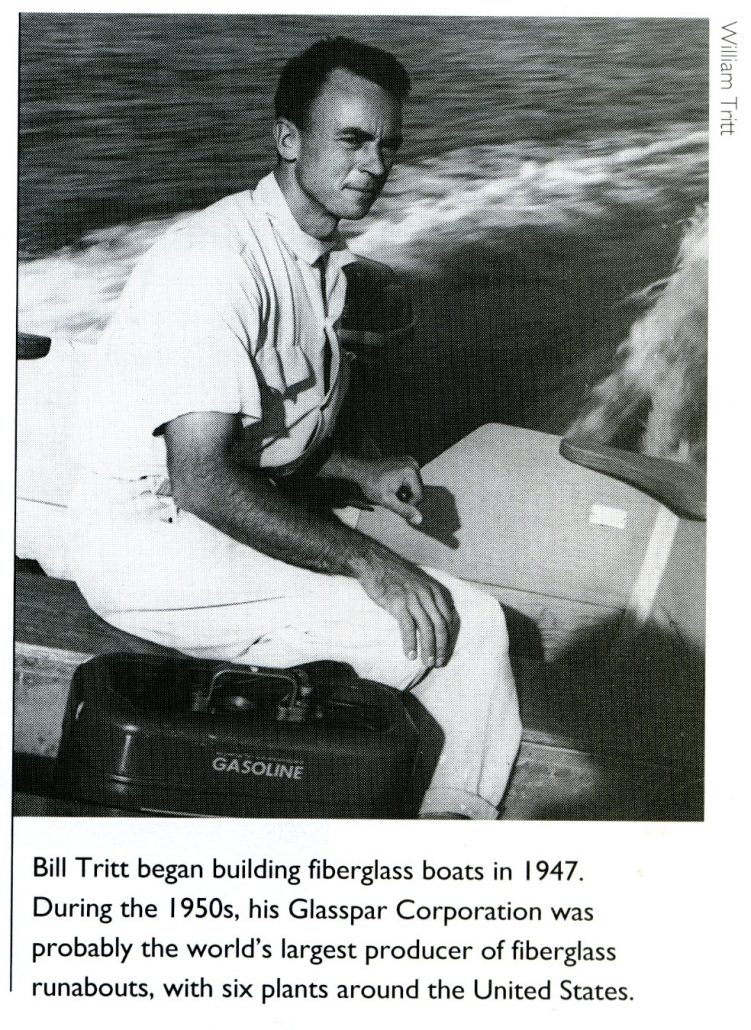
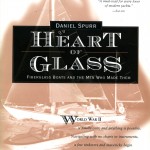
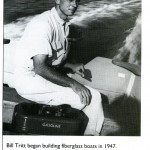
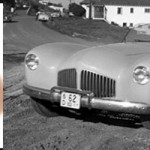
Hello Geoff.
My father, Bill Lowder was an employee of Glaspar in the R&D department. I was rather young in those days, but my father would take me to work quit often at the R&D building in Costa Mesa. Bill Tritt allowed me to tag along on many trips to the Newport Back Bay for boat testing. I was also a guest on many Ocean tests/fishing trips on the Meridian Yacht Co. boats. The 30 footer and the 24 footer. I was given an eight foot model of the 30 footer that was used for hull tests. The perfect gift for a 12 yr old. about five years ago I saw a 30 foot hull for sale in Ventura California.Later,when Bill Tritt left Glaspar and moved to Montecito, CA. My father also moved to Santa Barbara to run Bill’s new company “Hudson River Boat Co. I also worked for Bill at that company. He made a Portugese style double-ender I believe Bill Moved to Trinidad and we lost contact with him.. If you would like to connect me, my Number is 805-336-5899 or terrylowder@yahoo.com